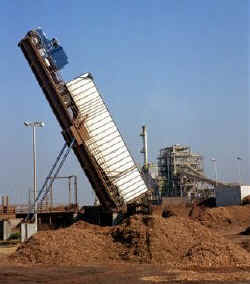Note: The Biomass Energy Foundation (BEF) was dissolved in 2013. This webpage was originally authored by Dr. Thomas B. Reed and appeared on the BEF website.
Biomass – The Only Renewable Fuel

Truck Unloading Wood Chips
The name “Biomass” was invented about 1975 to describe natural materials used as energy sources. The Office of Technology Assessment (OTA) estimated in 1980 that biomass could potentially supply more than 20% of US energy requirements – if we were serious about energy independence (we’re not, since oil and oil profits are international). Biomass now supplies 5% (updated for November 2016) of US energy (see EIA and their table of biomass consumption).
While biomass is one of the best forms of renewable energy, it is not a great fuel. It occurs in a wide variety of forms (wood, paper, trash, …). This can be reduced by densification (pelletization) to a uniform fungible fuel that can be easily shiped, stored and used.
Biomass varies widely in both mass and volume fuel density. It varies in chemical composition and the proximate/ultimate analysis gives records this data. It often has high water content, and the different methods of recording and measuring MC can be confusing.
While biomass can be used directly (mostly in wood fires), it can be converted to higher forms of fuels. Biomass is converted to various fuel forms in thermal (combustion, pyrolysis and gasification) processes and biological (fermentation and digestion) processes. Click here for a road map to all the various biomass conversion processes.
Probably most of you were exposed to chemistry in high school and promptly forgot it. The chemistry of biomass and other conversion processes is very simple, involving primarily carbon, C, hydrogen, H and oxygen, O. A brief explanation is given here in terms of a “Ternary diagram” of fuels which will help to keep the chemistry of fuels straight in your minds.
Air Fuel Ratios for biomass pyrolysis, gasification and combustion:
Air is the primary requirement for these thermal reactions of biomass, and adjusting to the correct air fuel ratio has given us incredibly clean cars in the last several decades. Click here to see a diagram which shows the air-fuel ratios for pyrolysis, gasification and combustion of biomass.

One Inch Birch Dowel Pyrolysing At 600C
This website is devoted primarily to biomass gasification, the primary business and pleasure of Tom Reed over the last 3 decades. However, all combustion and gasification processes must pass through pyrolysis at low temperature, so there is a lot of information here about pyrolysis and combustion as well.
Biomass fuels are characterized by what is called the “Proximate and Ultimate analyses”. They can be burned directly for heat or to make steam for power. The “proximate” analysis gives moisture content, volatile content (when heated to 950 C), the free carbon remaining at that point, the ash (mineral) in the sample and the high heating value (HHV) based on the complete combustion of the sample to carbon dioxide and liquid water. (The low heating value, LHV, gives the heat released when the hydrogen is burned to gaseous water, corresponding to most heating applications.)
The “ultimate” analysis” gives the composition of the biomass in wt% of carbon, hydrogen and oxygen (the major components) as well as sulfur and nitrogen (if any).
The table of Proximate and Ultimate analyses is from Appendix A of our book, An Atlas of Thermal Data for Biomass and Other Fuels, Second Edition, and gives analyses of over 140 fuels, including biomass components, natural biomass (woods, agricultural products), processed biomass, other solid and liquid fuels.
